John Hancock Facts
John Hancock is one of the most important founding fathers. These John Hancock Facts cover his time as President of the Continental Congress, where he oversaw the Declaration of Independence, the adoption of the Articles of Confederation and the defeat of General Burgoyne at Saratoga, a pivotal turning point in the Revolutionary War.
On our John Hancock Facts page, you will also learn about John Hancock's family, read quotes by and about John Hancock and see pictures of many John Hancock Landmarks that are still standing today. Hancock was one of the most widely known and popular of the Founding Fathers in his day and today is known, of course, for the very large signature he put on the Declaration of Independence, declaring his contempt for King George III and his loyalty to all Americans. Enjoy these John Hancock Facts!
John Hancock Facts
John Hancock - Date of Birth
- January 23, 1737
John Hancock Birthplace
- Braintree, Massachusetts (the part of town that is now Quincy)
Parents' names
- Reverend John Hancock of Braintree, June 1, 1702 - May 7, 1744 (only 42 when he died)
- Mary Hawke Thaxter, October 13, 1711 - 1783
- John and Mary married on December 12, 1733. He was her second husband. She would marry a third time after his death.
Parents' occupations
- Rev. John Hancock was a graduate of Harvard in 1719 at the age of 17. He served as Harvard's librarian from 1723-1726. From 1726 until his death, he served as pastor of the church of the North Precinct (now called the United First Parish Church, nicknamed "Church of the Presidents") in the town of Braintree, Massachusetts (now Quincy). This church is the burial place of Presidents John Adams and John Quincy Adams.
- John's father died when he was only 7 years old and he went to live with his grandfather, the Reverend John Hancock in Lexington, where he lived until 1750. Reverend Hancock had another son named Thomas who lived in Boston with his wife Lydia. Thomas was the owner of a wealthy company that imported manufactured goods from Britain and exported whale oil, fish and rum. He was one of the wealthiest men in New England and founded a professorship of Oriental Languages and Hebrew at Harvard and donated generously to Harvard's library.
- Thomas and Lydia had no children and, consequently, no heir to take over the business. When John was thirteen, Thomas and Lydia adopted him. The elder Rev. Hancock intended for John to follow in his and his father's footsteps and become a minister. When Thomas adopted him, however, he promised to send John to Harvard, but also intended to have him take over his business when he was of age. Thomas became the primary influence in John's life after the adoption.
Number of siblings
- 2
John Hancock Facts - Birth order
John Hancock was the 2nd of Rev. John Hancock's 3 children:
- Mary - 1735 - 1779
- John - 1737 - 1793
- Ebenezer - 1741 -1819, Ebenezer served as deputy paymaster general of the Continental Army during the Revolutionary War beginning in June 1776. He graduated from Harvard in 1760. He was also a Keeper of the Powder House in Boston, Fire Warden, Inspector of the Massachusetts Mint and Town Selectman in Boston.
John's mother Mary remarried after the Reverend's death and with her new husband also had two half-siblings to John, a boy and a girl, but they were both stillborn.
Personal Information
Nicknames and Pseudonyms
- King Hancock, for his great wealth
John Hancock Education
- John Hancock went to Boston Latin School, the oldest educational institution in the colonies and graduated in 1750 at 13. Then he went to Harvard where he studied Latin, religion, physics, geometry, astronomy, geology and arithmetic, receiving a Bachelor's Degree in Classical Studies in 1754. After graduating he went to work for his uncle's firm.
John Hancock Facts - Religious Views
John Hancock's father and grandfather were both Congregationalist ministers and graduates of Harvard's ministerial school. Had John's father not died when he was young, he likely would have followed in his father's footsteps and become a minister, as many sons did at that time. After his father's death, John went to live with his grandfather until the age of 13. Hancock's grandfather John was minister of the Congregationalist church in Lexington for literally decades and was known as the "Bishop" by area churches.
John Hancock was a lifelong member of the Brattle Street Congregationalist Church. His name was inscribed on the cornerstone of the church for the 1,000 pounds he gave when the church was built. He also bought the church's bell. He also gave a Bible to a church in Lunenberg and bought another bell for a church in Jamaica Plain.
He made frequent appeals to God in his role as President of the Continental Congress and Governor of Massachusetts. In these public positions, he made many statements of praise and thanks to God for His blessings in the fight for independence, made public requests for prayer and repentance and asserted that God was in control of America's destiny. Hancock also advocated state support of religious institutions.
Some statements revealing his religious faith from some of his public statements and proclamations include:
- In a letter to the Continental Army in March 1776, Hancock proclaimed that the same God who had foiled British efforts to conquer Massachusetts would defeat their "deep-laid scheme" against the other colonies as well.
- In an appeal to all the colonies in September 1776, he stated that members of Congress relied "on Heaven for the justice of our cause."
- He also said, "I am persuaded under the gracious smiles of Providence, assisted by our own most strenuous endeavors, we shall finally succeed."
- From his inaugural address as governor in 1780, Hancock thanked God for "the peaceable and auspicious" adoption of the new state constitution.
- In 1782 Hancock reassured members of the Massachusetts legislature that "the favor of heaven" would eventually establish America's righteous claims.
- Hancock's Thanksgiving proclamation the following year encouraged citizens to express their gratitude for God's numerous blessings and to recognize that their "entire Dependence" was on "His Goodness and Bounty."
When Hancock died, the Reverend Dr. Thatcher, Hancock's pastor at Brattle Street Church, delivered the eulogy. He made the following comments about Hancock's religious commitment:
- "His reverence for religion was never lost. He was interested in every thing that related to the house of God. He exceeded his worthy ancestors in his liberality to this society and proved his real attachment to our peace and happiness. It might have been said of him as of the centurion by the Jews,'He loved our nation and hath built us a synagogue.'"
John Hancock Facts - First Occupation
- John Hancock went to work for his uncle's firm, the House of Hancock, after graduating from Harvard. He began to be trained to become a full partner in the business. Hancock served in this position for many years and became a full partner in 1763 when his uncle's health began to fail. Thomas Hancock died in August, 1764 and John inherited the business, the estate and 22,000 acres of land in Massachusetts, Connecticut and Maine, making him one of the wealthiest men in the colonies.
- Later, during the Revolutionary War, Hancock would serve as the President of the Continental Congress and become the first Governor of the State of Massachusetts
Trips abroad
- John Hancock made only one trip away from America in his life. He lived in London from 1760-1761 while on business for his uncle. John engaged with some of the leading businessmen in England at the time. While on this trip John witnessed the coronation of King George III on September 22, 1761, the king whom he would later refuse to serve and fight directly against during the Revolutionary War. Another American was also present and witnessed the coronation - Benjamin Franklin, whom John did not yet know personally.
The Hancock Family
Date of marriage, wife's name
- Dorothy "Dolly" Quincy - Married August 28, 1775. The couple married at Fairfield, Connecticut shortly after the American Revolution began while the Second Continental Congress was on a recess where John oversaw the war effort in his position as President. Dorothy and Hancock's adoptive Aunt, Lydia Hancock, were staying temporarily in Fairfield because of the unrest in Boston. Dorothy was staying with John and Lydia in their mansion on Beacon Hill and had been engaged to him while there.
Children's names, birth order, occupations
- Lydia Henchman Hancock - October, 1776 - November, 1777. Lydia died in infancy.
- John George Washington Hancock - May 21, 1778 - January 27, 1787. John died at the age of eight as a result of a head injury suffered in an ice skating accident.
Famous relatives
- Dorothy Quincy, John Hancock's wife, was a cousin to Elizabeth Quincy Smith, the mother of Abigail Adams, wife of Signer of the Declaration of Independence and President John Adams. Other prominent members of the Quincy family include future President John Quincy Adams, Supreme Court Justice Oliver Wendell Holmes, last Royal Attorney General of Massachusetts Jonathan Sewell and Revolutionary War soldier Josiah Quincy.
John Hancock Facts - Hancock Coat of Arms
- The Hancock family Coat of Arms consisted of a hand beneath three cocks with a griffin (half lion, half eagle) above all.
John Hancock Homes
- The Hancock-Clarke House in Lexington, Massachusetts is the home where John Hancock lived with his grandfather, the Reverend John Hancock, after John's father died. Hancock lived here for six years until he moved to Boston and was adopted by his uncle Thomas. The Reverend Hancock was succeeded by the Reverend Jonas Clarke, who lived in the house and raised twelve children there.
- On the evening of April 18, 1775, the eve before the Revolutionary War began, John Hancock and Samuel Adams were staying with Reverend Clarke because it was too dangerous to return to Boston. This is where Paul Revere and William Dawes arrived separately on horseback to warn the men that the British were coming, before riding on toward Concord. The house still stands and is owned by the Lexington Historical Society. Visitors are welcome from April through October.
- After moving in with his uncle after his father died, John Hancock grew up in Hancock Manor, his uncle's luxurious estate on Beacon Hill in Boston. The home stood until the 1860's when efforts to restore it failed. The state capitol stands on the grounds today. This is a picture of the actual home around 1860. It was torn down in 1863.
- In 1925, Horace Moses constructed the Hancock House in Ticonderoga, New York, an exact replica of Hancock Manor for the New York State Historical Association, as a museum for "American Traditions in History and the Fine Arts." The Association used the house as its headquarters until after World War II. Today it is owned by the Ticonderoga Historical Society and serves as a regional museum and library. You can visit today and learn more about the John Hancock House here.
- A replica of John Hancock's house was built for the Chicago World's Fair in 1893. The house served as a museum at the fair.
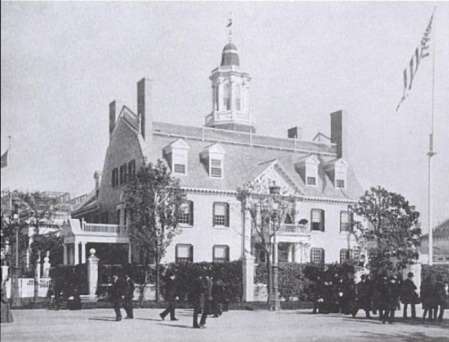 John Hancock House replica,
Chicago World's Fair, 1893
John Hancock House replica,
Chicago World's Fair, 1893- The Dorothy Quincy House in Quincy, Massachusetts, also known as the Quincy Homestead, is the childhood home of Dorothy Quincy Hancock, wife of John Hancock. The home served five generations of Quincys and is open to the public. It is on the National Historic Landmark, owned by the State of Massachusetts and operated by the National Society of The Colonial Dames of America in the Commonwealth of Massachusetts. It is open on Saturdays during the summer. You can learn more about the Dorothy Quincy House here.
The Revolutionary War
How he got involved in the independence effort?
- John Hancock became involved in the independence effort through the events of several years' time beginning in 1765 when he was elected to Boston's Town Council as one of the five Selectmen, a position his rich uncle held for many years. Shortly after his election, the Stamp Act was passed by Parliament to tax all legal and contractual transactions on paper that was to be stamped with an official seal. Many colonists believed this was an illegal tax because they were not represented in Parliament. They had always been taxed only by their own elected representatives in their own legislatures. As the owner of a large shipping firm, John Hancock was particularly affected by the Stamp Act with loads of paperwork and heavy taxes. He was very vocal in his opposition, though at first he believed it should be obeyed until a repeal could take place. After a few months, Hancock changed his mind and joined the resistance. He joined in the Boston merchants' boycott of British goods, impacting his own business, though he still disapproved of mob intimidation and violence toward officials. Many royal officials were burned in effigy or had their homes ransacked for supporting the Stamp Act, including the Lieutenant Governor, Thomas Hutchinson. The Massachusetts House of Assembly called for a meeting of all the colonies to meet in New York in October, 1765, to discuss a unified response of the colonies to resist the Stamp Act. The meeting is known as the Stamp Act Congress. John Hancock was one of the Massachusetts representatives chosen to attend the Stamp Act Congress, which produced several statements of the colonists' rights and grievances.
- His participation in the boycott of British goods made him popular in Boston and after the Stamp Act was repealed in March 1766, Hancock was elected to the Massachusetts House of Representatives in May, along with James Otis, Thomas Cushing, and Samuel Adams. Samuel Adams, one of the most vocal and ardent opposers of British tactics and was the Clerk of the House of Representatives. The two became close associates. Many people view them in a mentor/protege light and credit Adams with engineering Hancock's rise to political prominence. Adams may have promoted Hancock in order to exploit Hancock's wealth to resist the British, but he undoubtedly also respected Hancock's own political senses.
- In 1767, Parliament passed the Townshend Acts, a series of Acts designed to increase revenue and decrease smuggling. Colonists were involved in smuggling to avoid paying taxes and to find more lucrative markets outside the British Empire. The colonists were outraged at the Acts and Boston merchants, including John Hancock, again boycotted British goods until the Townshend Acts would be repealed. Part of the Townshend Acts involved much stricter enforcement by customs officials and Hancock was continually targeted by them because of his high profile and large shipping business. His ships and warehouses were the continual target of snooping officials. They may have suspected him of smuggling or were simply targeting him because of his high profile. On April 9, 1768, two customs officials boarded his brig Lydia and demanded to search her goods below deck. Hancock was called and when he arrived he found that the officials did not have a writ of assistance (a search warrant) so he forbade them from searching the ship. Later one of them snuck below deck and when he was found he was forced out of the hold by Hancock's employees. Later on, some viewed this as the first act of physical resistance to the British and credited Hancock with beginning the Revolutionary War. Some wanted to charge Hancock with resisting the law for barring the officials from searching his ship, but the charges were dropped by Massachusetts Attorney General Jonathan Sewell, who investigated the matter and determined that Hancock had not violated any laws.
The Liberty Incident
- On May 9, 1768, Hancock's sloop Liberty arrived in Boston with a shipment of Madeira wine. The following day the ship was inspected by customs officials who accused him of smuggling. They found only 25 caskets of wine on board, but the ship's capacity was much greater. They suspected him of removing much of the cargo in the night. This was never proved however because the two customs employees on board the ship for the night both said that no such thing happened. A month later, one of these employees changed his story and said he was forced to remain quiet while the cargo was removed in the night. On June 10, officials seized the Liberty, which had been filled with new cargo and towed it out to be guarded by the warship HMS Romney in the harbor. The citizens of Boston were outraged and began to riot. Several customs officials' homes were destroyed and many of them fled to the Romney and then to Castle William, a fort on an island in the harbor. Hancock was the victim of two lawsuits as a result. John Adams, the future president and signer of the Declaration of Independence, was Hancock's attorney. The first was filed on June 22, 1768, concluded in August and resulted in the confiscation of the Liberty, which was put into the customs service. It was burned by angry colonists in Rhode Island the following year. The second suit began in October and accused Hancock of illegally unloading 100 caskets of wine without paying the duty on them. This was a highly public trial in a vice admiralty court that had no jury and often barred Hancock from cross examining witnesses. After dragging on for five months the case was inexplicably dropped, probably for lack of evidence. Hancock's alleged involvement in smuggling has never been proven by historians, even though he has the reputation of being a first rate smuggler. All of the concrete evidence that exists of Boston merchants involved in smuggling does not contain any references to Hancock. Of course, smuggling was a clandestine affair for which records were not kept. Most likely he was peripherally involved in smuggling, but does not deserve the "King of Colonial Smugglers" title which he has been given. The Liberty affair cemented Hancock as a martyr and patriot in the eyes of fellow colonists.
- In September, Hancock and other Boston selectmen called for a mass "town meeting" to be held at Faneuil Hall in Boston. He sent a letter to towns across Massachusetts inviting them to send representatives to address the Townshend Acts. 96 towns were represented at the meeting held on September 28th. They produced a list of grievances and passed several resolutions condemning the Acts. You can read the text of the circular letter sent by John Hancock and the other Boston selectmen here. Two days after this meeting, British soldiers arrived and began their military occupation of Boston.
- Tension between colonists and British soldiers turned bloody in March 1770 when soldiers fired on a crowd that was taunting them. This event became known as the Boston Massacre. Afterwards, John Hancock led a delegation from the city that met with the Governor and the Colonel in charge of the troops and demanded that they remove the troops from the city or else 10,000 armed colonists would march on Boston. The officials knew this was a bluff, but also knew the soldiers presence in town could incite more violence and so removed the troops to Castle William in the harbor. Hancock was celebrated as a hero for helping get the troops out of town and was reelected to the House of Representatives nearly unanimously in May.
- The Townshend Acts were repealed in 1770 and things quieted down in Boston. In April, 1772, Governor Hutchinson tried to pull John Hancock into his camp by appointing him colonel of the Boston Cadets. This was a militia unit that was in charge of providing a ceremonial escort for the governor and General Court. In May, Hutchinson also approved Hancock's election to the Council, which was the Upper Chamber of the General Court. The Council was elected by the legislature, but their choices could be vetoed by the governor. Hancock had been elected to this position several times before, but the governor had always vetoed his election. John Hancock declined the position however, not wanting to seem as if he was in the governor's hand.
- In 1773, Hancock was involved in the public revelation of some of Governor Hutchinson's private letters which recommended to Parliament that the rights of the colonists to govern themselves should be taken away in degrees. Benjamin Franklin had sent the letters from England to patriot leaders in Boston, but asked that they be kept private. Hancock, Samuel Adams and others were involved in getting the letters published in the Boston Gazette in June. Hutchinson was forced out of office as a result of the outcry.
- In 1773, Parliament passed the Tea Act, which placed a tax on imported tea. The colonists were outraged at yet another attempt by Parliament to tax them. John Hancock was appointed moderator of a Boston Town Meeting on November 5th that adopted a resolution stating that anyone who supported the Tea Act was an "Enemy of America." Hancock and others tried to force out the agents appointed to collect the tax, but were unsuccessful. In December, three ships with tea arrived in Boston Harbor and Hancock was present at a meeting where the colonists planned to prevent the unloading of the tea. He allegedly said at the meeting, "Let every man do what is right in his own eyes." On the evening of December 16th, disguised colonists boarded the ships and threw the tea into the harbor. Hancock was not present at the Boston Tea Party, but approved of the action, though he was careful not to endorse the destruction of private property publicly. Once the event was known in England, Parliament shut down the harbor with a naval blockade called the Boston Port Act and sent more soldiers to Boston, which helped precipitate the Revolutionary War.
- Parliament passed a series of acts known as the Intolerable Acts to gain better control of Boston. The acts took away the right of the colonists to elect people to most public offices and gave the right to the Royal Governor instead, forced colonists to house British troops on their own property, severely limited the colonists from holding town meetings and gave the governor the right to send trials of royal officials to other colonies or even back to England if he thought they couldn't get a fair trial in Massachusetts. These acts caused great alarm in all the British colonies, which feared that England would try to take away their rights as well.
- On March 5, 1774, John Hancock was chosen to give the annual address at a public commemoration to those who died in the Boston Massacre. He delivered a scathing attack on the British government that cemented his popularity in the eyes of the people. The speech was reprinted in newspapers around the colonies. Read the John Hancock Boston Massacre Oration here.
- Later that year, Governor Hutchinson was replaced with a new governor, General Thomas Gage, who arrived to enforce the Intolerable Acts. Gage removed Hancock from his position as colonel of the Boston Cadets. In October, Gage cancelled the regular meeting of the Massachusetts Colonial Legislature. In response, the House of Representatives met on their own independently as the Massachusetts Provincial Congress, completely free of all British rule. John Hancock was elected President of the Provincial Congress and to its powerful Committee of Safety. The Provincial Congress created the minutemen divisions that were to be ready to respond to a call to arms at a minute's notice. John Hancock helped finance them.
The Revolutionary War begins!
- On December 1, 1774, the Provincial Congress elected John Hancock as a representative to the Second Continental Congress, which was to meet in Philadelphia in May, 1775 to coordinate colonial protests against Britain and defense of colonial rights. In February, 1775, Hancock was reelected President of the Provincial Congress. Hancock attended the Provincial Congress in Concord in April. When it was over, believing it was too dangerous to go back to Boston, he and Samuel Adams decided to stay in Lexington before leaving to attend the Continental Congress in Philadelphia. On the night of April 18th, General Gage sent a detachment of troops to Concord to confiscate the colonists' supplies of arms and ammunition held there. They would have to pass through Lexington on the way. Gage had received a letter from Lord Dartmouth instructing him "to arrest the principal actors and abettors in the Provincial Congress whose proceedings appear in every light to be acts of treason and rebellion." General Gage's order that night instructed the soldiers to capture the patriots' arms, but did not specifically mention capturing Hancock and Adams. The patriot's however believed they were in imminent danger and Joseph Warren dispatched Paul Revere and William Dawes to warn Hancock and Adams that the British were coming for them and to warn the towns of Lexington and Concord to prepare for battle. Revere and Dawes arrived in Lexington around midnight with the warning. Hancock immediately began preparing his gun and dispatched someone to start ringing the bell at the local meeting house which rung all night, arousing the sleeping citizens and calling them to arms. It took some time for Reverend Clark, with whom they were staying, and Samuel Adams to persuade Hancock that it was not in the best interest of Massachusetts for someone in his position to be caught fighting the enemy, but that he would be more useful in governing. Hancock's aunt Lydia was also there, as well as Dorothy Quincy, Hancock's future wife and a cousin of Lydia's, who had been staying with the Hancocks on Beacon Hill. Hancock and Adams escaped town and the first shots of the American Revolution were fired at dawn on Lexington Green.
- Hancock made his way to Philadelphia where he was elected President of the Second Continental Congress, where he oversaw the war efforts of the entire colonies.
- After the events at Lexington and Concord, General Gage issued a pardon to everyone that would "lay down their arms, and return to the duties of peaceable subjects..." - EXCEPT for Samuel Adams and John Hancock! Read General Gage's Proclamation here.
- ... and THAT is how John Hancock got involved in the War of Independence!
Did he see military action during the war?
- John Hancock was appointed Senior Major general of the Massachusetts militia in 1776, but was away most of the time in his duties as President of the Continental Congress. In the summer of 1778, he got his chance for military action however. The French fleet had just come to help the Americans and General Washington ordered an attack on the British troops at Newport, Rhode Island. General John Sullivan led the American troops. John Hancock returned to Boston to lead 6,000 militiamen into the Newport campaign, although he let the more seasoned soldiers do all the planning. Thousands of Americans marched to Newport, but the Battle of Rhode Island was a disaster for the Americans when the French Admiral D'Estaing pulled out and did not land his troops after a bad storm damaged his fleet. Much of Hancock's militia deserted. He and the other generals involved were criticized for the failed operation. D'Estaing's fleet went to Boston for repairs, but the citizens of Boston were angry with them for the failed mission. John Hancock quickly went back to Boston to try to relieve tensions between the two groups. A riot ensued the day the French landed in Boston and animosity was high between the French soldiers and Boston's patriots. Hancock reached out to the French, inviting 40 officers a day to dine at his house and throwing a ball for 500 soldiers. The effort helped calm the French soldiers, but Hancock still referred to them as "Philistines" in this private letter when they came to his house - John Hancock letter to Henry Quincy, August 30, 1778. Some commentators credit Hancock's intervention with the continuing participation of France in the war. The French were so angry with the Americans' disgust with their pulling out of Rhode Island that they came near to pulling out altogether. Hancock's diplomacy may have changed their minds and ensured their involvement, which would be crucial to winning the war in the days ahead.
John Hancock Facts - Accomplishments during the war
- On June 17th, 1775 Congress appointed George Washington as Commander in Chief of the Continental Army. In his role as President of Congress, John Hancock signed George Washington's commission.
- On July 9, 1778, John Hancock signed the Articles of Confederation. This was the first governing document for the new states. Delegates from seven states signed the document, but the other states were not yet ready to accept the new form of government so the Articles would not be ratified until 1781. The Articles of Confederation featured a very weak central government that was not strong enough to sustain itself. Consequently, the Articles were done away with and the United States Constitution took its place.
- In October of 1780 the new Massachusetts Constitution went into effect. John Hancock was elected the first Governor of Massachusetts, a position he was continually reelected to for the rest of his life, with the exception of a period from 1785 to 1787 when he resigned, saying he was too sick to run again. His resignation was a probably a result of the increased tumult in the countryside that became known as Shay's rebellion. There were great economic difficulties during this period and the farmers in the countryside were blaming the government. Hancock's policies as governor may have contributed to the economic problems and, as Governor of Massachusetts, he was an easy target. Once the conflict was over and dealt with by his successor, Governor James Bowdoin, Hancock ran again and was reelected continuously until his death.
- While he was President of Congress, John Hancock oversaw - the appointment of George Washington as Commander in Chief of the Continental Army; the Declaration of Independence; and the defeat of General Burgoyne at Saratoga, a major turning point in the war.
Offices Hancock Held
John Hancock Facts - Which government offices did he hold?
- Selectman, Town Council of Boston 1765 - 1774
- Massachusetts Representative to the Stamp Act Congress - October, 1765
- Under Royal Government, Representative to Massachusetts House of Representatives, May 1766 - 1774
- Overseer and Colonel of Boston Cadets, the Royal Governor's personal guard, April, 1772 - 1774
- Massachusetts General Court, this is the upper house of the Legislature, an advisory position to the Royal Governor - May 1772 - 1774
- Treasurer of Harvard University, 1773
- Elected President of Massachusetts Provincial Congress - 1774 - 1775
- Massachusetts delegate to Second Continental Congress, December 1774 - 1780
- President of Second Continental Congresses, May 24, 1775 - October, 1777
- Sat on the Marine Committee in the Continental Congress, helping create a fleet of thirteen frigates for the colonists, including the USS John Hancock.
- First Major General of the Massachusetts Militia, February 8, 1776 -
- President of Massachusetts State Convention to accept Articles of Confederation, January, 1778
- President of Massachusetts State Constitutional Convention, 1780
- Governor of Massachusetts, 1780 - 1785 and 1786 - 1793
- Massachusetts representative to Confederation Congress, 1785 - 1786
- Again elected President of the Continental Congress on November 23, 1785, but resigned May 29, 1786, not having served due to illness
- President of Massachusetts Convention to ratify the US Constitution, January 1788
Did he hold any office under the Royal government?
- Representative to Massachusetts House of Representatives, May 1766 - 1774
- Overseer and Colonel of Boston Cadets, the Royal Governor's personal guard, April, 1772 - 1774
- Massachusetts General Court, this is the upper house of the Legislature, an advisory position to the Royal Governor - May 1772 - 1774
John Hancock Facts - Which party was he in?
- John Hancock was believed to be an anti-Federalist at the beginning of the Constitutional question. He believed the new Constitution gave the federal government too much power at the expense of the states and that it did not protect the people's rights. During the Massachusetts Ratifying Convention, of which he was elected President, he was approached by Federalists who supported the Constitution. They persuaded him to put his support behind the Constitution if a Bill of Rights was added that specifically listed the protected rights of the people that could not be infringed upon by the government. The Federalists may have also hinted to Hancock that they would support his election as the first President of the United States if he supported them. Hancock put his support behind the Constitution if it had a Bill of Rights. He addressed the Ratification Convention and encouraged their support, stating that their concerns about the rights of the people would be protected by a Bill of Rights. Enough of them were persuaded to ratify the Constitution by a narrow margin. The Constitution would probably not have been ratified by Massachusetts if it had not been for Hancock's support. After the ratification, the Federalists were thrilled with Hancock and continued to vote for him and support his political career, electing him as Governor of Massachusetts every year until his death.
Interesting Personal Information
- John Hancock was a boyhood acquaintance of young John Adams, who would become another Revolutionary War patriot and the 2nd President of the United States. They grew up in the same town and Hancock was about a year and a half older than Adams.
- John Hancock was only 27 years old when his uncle Thomas died and left him his business, the House of Hancock, making John one of the wealthiest men in the colonies.
- Hancock inherited what was thought to be the most valuable tract of land in New England at his uncle's death, most of it was inhabited, however, by Loyalists. John also did most of his business dealings with Loyalists, who were in positions of influence and authority. This did not stop him from supporting the patriot cause however. John Hancock was known for his populism and support of the common man.
- In 1772, John Hancock commissioned the famous Boston portrait painter John Singleton Copley to paint portraits of Samuel Adams and of himself. Copley was Hancock's neighbor on Beacon Hill. The painting of his political mentor Samuel Adams, is the most famous painting of Adams. The two portraits hung in John Hancock's mansion for 50 years. Then they were moved to Faneuil Hall. Today the originals are housed in the Museum of Fine Arts in Boston.
- When John Hancock was elected President of the Continental Congress, he was chosen by a unanimous vote.
- Hancock was sometimes criticized for his lavish style and luxurious tastes. Of course, he was used to a life of opulence because he was one of the wealthiest men in the colonies, having inherited his uncle's wealthy import/export business, the House of Hancock. Hancock was known for his extravagant clothing and while serving as President of the Second Continental Congress he rode in a fancy chariot escorted by fifty armed horsemen plus servants!
- In 1774, the Massachusetts Provincial Congress issued a proclamation for a day of Thanksgiving to God. John Hancock was president and the proclamation was signed by him. It was the first proclamation issued in the colonies with no mention of King George III.
Other John Hancock Facts
- John Hancock was known as Johnny when he was a boy.
- Around the time John Hancock arrived in Philadelphia to attend the Continental Congress, where he was chosen its President, his home back in Boston had been taken over and was being lived in by General Henry Clinton, commander of the British forces occupying Boston. Soldiers would camp out in his yard and cut the fence down for firewood.
- When John Hancock went to London for business at 23, he traveled with Governor Thomas Pownall, former governor of Massachusetts, whom John's uncle Thomas had enlisted to escort the boy.
- Shortly before the Battles of Lexington and Concord, British soldiers tarred and feathered a local citizen. John Hancock was part of a committee that investigated the matter. He was targeted by angry British soldiers who hacked up the fence around his house with swords and entered his grounds where they threatened that his house and stable would soon be in their hands.
- On June 15, 1775, the Continental Congress, including the other Massachusetts delegates, nominated George Washington to be the Commander of the Continental Army. John Adams wrote many years later that John Hancock was very disappointed that he had not been named to the position himself. Adams said Hancock was visibly upset when he first found out, but from then on he did not show his disappointment and supported Washington in every way he could.
- In late 1775, when the Continental Army was surrounding Boston, it was proposed that the Army bombard Boston and destroy the entire town. John Hancock would have lost everything, but he agreed to the plan anyway, believing the cause to be more important than his personal wealth.
- Hancock received an enormous amount of wealth and a thriving business when his uncle Thomas died, but Hancock was not the best manager. Hancock closed the House of Hancock permanently in 1775. Business was becoming harder and harder to operate with pressure from the British government and due to colonial boycotts of British goods. Hancock also made some unwise business decisions, all of which contributed to his declining business. The closing of his business may have also been the reason he became so heavily involved in politics.
- When the British cordoned off Boston in 1775, many leading citizens and patriots fled the city until calmer times prevailed. Lydia Hancock, John Hancock's aunt and Dorothy Quincy, his fiance, went to Fairfield, Connecticut where they stayed in the home of Thaddeus Burr, an old family friend. Thaddeus Burr was a local politician and wealthy landowner. His brother, Aaron Burr, Sr. was a minister and co-founder of Princeton. Aaron's wife Esther was the daughter of the famous Great Awakening minister Jonathan Edwards. Aaron and Esther were the parents of Aaron Burr, Jr., who became a Revolutionary War hero, future Senator from New York and Vice President under Thomas Jefferson. Later, Aaron was famously involved in a duel with Alexander Hamilton in which Hamilton was killed.
- During the time Lydia and Dorothy were staying with Thaddeus Burr, the young Aaron Burr came to live with him for a time. Aaron had been raised by his uncle, Timothy Edwards, in New Jersey after his parents' death, but he was attending law school in Litchfield, Connecticut, not far from Thaddeus Burr's home in Fairfield, when the war broke out. Aaron was a very handsome and charming young man that many young women had their eye on. Dorothy Quincy was one of the most eligible young women in Boston and even though she was engaged to John Hancock, she expressed interest in Aaron Burr in private letters. Lydia Hancock was aware that John might be left behind if a flame was kindled between Dorothy and Aaron and she refused to let them spend even one moment together alone.
- Soon Aaron was called into military service, where he became a Revolutionary War hero at the Battles of Quebec and Manhattan. John Hancock returned to Fairfield during a congressional break in the summer of 1775 and he and Dorothy were married at Thaddeus Burr's home on August 28. Dorothy then moved to Philadelphia with John, where she stayed at the same inn where many of the congressional representatives were staying... one woman with 100 men, according to John Adams, who wrote about Dorothy's polite manners in a letter to his wife Abigail.
- Lydia Hancock was preparing to go back to Boston in April 1776 after the British army finally left the town. She died of a stroke on April 15 just before her planned departure. She was buried in Fairfield under a gravestone erected by Thaddeus Burr.
- In 1779, Fairfield was invaded by the British and many homes were destroyed, including the home of Thaddeus Burr. Eunice Burr, Thaddeus' wife was at home when the army invaded. Many leading citizens had fled the town, but she stayed in hopes that her presence would prevent the soldiers from entering her home. She pleaded with Governor Tryon, a long time family friend, to prevent the soldiers from destroying their belongings, but the home was destroyed and the soldiers stole the ring off her finger and the silver buckles off her shoes.
- Shortly afterwards, John Hancock surveyed the destroyed home with Thaddeus Burr and they talked about rebuilding. John told Thaddeus that if he would build himself a replica of Hancock's Beacon Hill home, he would pay for the windows for the entire house. Thaddeus took him up on the offer and built an exact replica of Hancock Manor. The home still stands today on Old Post Road in Fairfield. The home looks somewhat different now than it did originally because it was remodeled in the 1840's. The dormers were removed and a large veranda and columns were added to the front. The home is now owned by the City of Fairfield and can be rented out for events.
Read on for more John Hancock Facts
- In 1767, John gave 1,098 books to Harvard's library. Here is a list of the books in John Hancock's personal library upon his death.
- As governor, John Hancock encouraged passage of a law that required towns with at least 200 people to employ school teachers who could teach their students Greek and Latin. Smaller towns had to have teachers who were proficient in English.
- In 1822, former President John Adams deeded property to the city of Quincy, Massachusetts to be used for a church and a boys school. Part of the property he gave was the site of the home John Hancock was born in and that was later home to Josiah Quincy Sr. and Josiah Quincy, Jr. That house burned down in 1760. Adams specified that the boys school be built on the site of Hancock's home. The Adams Academy opened in 1872 and functioned until 1908. Today the building is owned by the Quincy Historical Society and contains a museum about the history of Quincy from Indian times until today. Visit the Quincy Historical Society website here.
- John Hancock suffered from gout for most of his life, which is a debilitating joint disease. This is the reason why he left public office a few times and was often not able to serve.
- On the day John Hancock resigned as President of Congress due to ill health, Congress drew up a letter of thanks for his service. Several members, including Samuel Adams, blocked the letter though, because they thought it was inappropriate to express thanks to a President of Congress. Hancock was offended by Adams' sleight and their relationship was never the same again. Both had differing views and fell into different factions as the new nation was formed. Their earlier political partnership ended as the new republic was beginning.
- John Hancock's finances suffered tremendously during the war, but he remained popular and was known for his philanthropy, helping widows and orphans, loaning money to those in need, assisting people who lost businesses and homes in Boston's many fires and helping to rebuild the city after the Revolutionary War.
- John Hancock was 39 years old when he signed the Declaration of Independence.
- John Hancock's fortune diminished considerably during the Revolutionary War. In 1781 he wrote Robert Morris, a financier of the Revolution, asking if Congress would reimburse him for his expenses when he was President of Congress. He estimated that 1,500 pounds would not be enough to cover all his expenses. There is no record showing that he was ever paid for his service.
- One of John Hancock's most important contributions to the Revolutionary War was to accept the Continental currency for payment from his debtors. This was money printed by Congress to pay its debts. Many people doubted its worth and would not accept it as payment. Hancock, however, accepted it, in an effort to increase the nation's faith in the fledgling government.
More Interesting John Hancock Facts
- John Hancock received 4 electoral votes to become the first President of the United States in 1789, but of course George Washington was the victor. Hancock's fellow Boston politician John Adams received the second highest number of votes and thus became Vice President.
- In the first election for governor of the new State of Massachusetts in 1780, John Hancock received 11,000 out of 12,281 votes, showing his huge popularity there.
- John Hancock was elected nine times as Governor of Massachusetts, frequently with more than 80% of the vote.
- John Hancock was elected President of the Massachusetts Provincial Congress that ratified the Massachusetts Constitution. This Constitution abolished slavery in the new state.
- As governor of Massachusetts, John Hancock encouraged and supported the passage of a law that banned all recreation on Sunday and encouraged people to go to church.
- After John Hancock's death, his wife, Dorothy, married Captain James Scott, a long time ship captain who had worked for her husband. She dined with the Marquis de Lafayette during his famous tour of the United States in 1825 and reminisced about the events of fifty years before. She died in 1830, thirtyseven years after John Hancock.
- The US Constitution was narrowly accepted by the Massachusetts ratifying convention. John Hancock served as President of the Convention and gave a last minute speech urging acceptance if the new Congress promised to pass a Bill of Rights. Many credit this speech with the Convention's approval of the Constitution.
- Most biographers acknowledge that John Hancock was very lavish and ostentatious and may have been overly interested in public praise and appearances. They also, however, acknowledge that Hancock's patriotism moved him to risk losing all the grandeur, pomp and prestige that his wealth afforded him, by choosing to take a strong stand against Britain, in order to obtain his greater love - liberty.
- John Hancock was considered for President in 1789 when George Washington was elected. He was also considered strongly for vice president, especially in the South. He was again talked about for President in 1785 by the southern states.
- Ten states have a Hancock County named for John Hancock. Hancock, Massachusetts; Hancock, New York; Mount Hancock, New Hampshire; and Hancock, Michigan are also named after him.
- The John Hancock Insurance Company was founded in Boston in 1862, but it has no personal connection to Hancock or his business. The John Hancock Tower in Boston and the John Hancock Center in Chicago take their names from this company.
- John Hancock was the Treasurer of Harvard from 1773 to 1777. He was serving as President of Congress at this time, was outside Massachusetts most of the time and was overseeing the war. He neglected to take care of matters back at Harvard and was eventually accused of mismanaging funds. Harvard appointed another treasurer in his place. Hancock probably didn't take the funds himself, but some money disappeared in the neglect. Hancock was embarrassed by the incident and paid $22,000 back to Harvard. In 1785, Hancock admitted he still owed $1,500 to Harvard, which wasn't paid until after his death from his estate.
- The US Navy has had six ships named after John Hancock. The USS Hancock, below, was a World War II aircraft carrier that saw action in the Philippines and Japan. It suffered a kamikaze attack during the war, but was repaired. The ship continued in service through the Vietnam era and was involved in the South Vietnamese evacuation of Saigon and finally retired permanently in 1976 and sold for scrap.
- The USS John Hancock was a destroyer launched in 1977. It was involved in the Persian Gulf War, but never saw any other major action. It was decommissioned in 2000 and scrapped in 2007.
John Hancock Facts - Works and Quotes
Selected works by and about John Hancock
- Thomas Hancock letter, May 21, 1760 - This letter was written from Thomas Hancock, John's adoptive uncle, to his business partners in London, when he sent John there on business, instructing them to take care of John when he arrives.
- John Hancock letter to Dorothy Hancock, May 7, 1775 - John Hancock wrote this letter to his wife after escaping from Massachusetts and arriving in New York safely to attend the Continental Congress.
- John Hancock Wedding Announcement, September 4, 1775 - This wedding announcement appeared in the New York Gazette seven days after he married Dorothy Quincy.
- John Hancock Letter to George Washington, July 6, 1776 - Hancock sent this letter to George Washington with a copy of the brand new Declaration of Independence, asking him to read it to the troops.
- John Hancock letter to New Jersey Convention, July 16, 1776 - John Hancock wrote this letter asking for the New Jersey Convention to send troops to New York as quickly as possible. It gives a good sense of the urgency of the times.
- John Hancock letter to Dorothy Hancock, March 10, 1777 - This letter shows the frustration and loneliness Hancock was facing during the war. John had returned to Philadelphia alone while Dorothy and their daughter were in Baltimore, where Congress had fled during the occupation of Philadelphia.
- John Hancock resignation letter as President of Congress, October 1777 - Hancock asked for a leave of absence for two months in this letter due to his health, but he did not return to the office.
- George Washington letter to John Hancock, October 22, 1777 - Washington wrote this letter to John Hancock after Hancock informed him he would be taking a leave of absence from his role as President of Congress. Hancock intended to resume his duties in a few months, but never returned to the position.
- Boston town meeting resolution regarding the return of Tories, August, 1778 - This resolution was passed by the town meeting of Boston after receiving a report from a committee chaired by John Hancock refusing the request of Tories to return to Boston.
Quotes by John Hancock
- "Let every man do what is right in his own eyes." - An alleged quote from Hancock at a meeting to plan the Boston Tea Party.
- John Hancock made his last public appearance on September 18, 1793, when he appeared before the Massachusetts Legislature. He told the legislators that he was so ill that they wouldn't be able to hear him if he spoke, so he sat by as the Secretary of State read his address. At the end of the address, Hancock made the following remarks, "I rely upon your candor to pardon this mode of addressing you. I feel the seeds of mortality growing fast within me. But I think I have, in this case, done no more than my duty, as a servant of the people. I never did and I never will deceive them while I have life and strength to act in their service."
- Hancock died three weeks later on October 3, 1793.
Quotes about John Hancock
- "It having pleased the Supreme Being, since your last meeting, in his holy Providence to remove from this transitory life our late excellent Governor Hancock, the multitude of his surviving fellow-citizens, who have often given strong testimonials of their approbation of his important services, while they drop a tear, may certainly profit by the recollection of his virtuous and patriotic example." - Opening remarks of acting Governor of Massachusetts, Samuel Adams, in the first legislative session to meet after John Hancock's death, January, 1794
- "Washington was in the minds of so many of the stanchest members that nothing could be done short of conceding to them. Mr. Hancock himself had an ambition to be appointed commander-in-chief. Whether he thought an election a compliment due him, and intended to have the honor of declining it, or whether he would have accepted it, I know not. To the compliment he had some pretensions, for at that time his exertions, sacrifices, and general merits in the cause of his country had been incomparably greater than those of Colonel Washington. But the delicacy of his health, and his entire want of experience in actual service, though an excellent militia officer, were decisive objections to him in my mind." - John Adams speaking about the selection of George Washington as Commander of the Continental Army rather than John Hancock
- "The two young men whom I have known to enter the stage of life with the most luminous, unclouded prospects, and the best founded hopes, were James Otis and John Hancock. They were both essential to the Revolution, and both fell sacrifices to it... They were the first movers, the most constant, steady, persevering springs, agents, and most disinterested sufferers, and firmest pillars, of the whole Revolution." - John Adams letter to Judge Tudor, June 5, 1813
- "Of Mr. Hancock's life, character, generous nature, great and distinguished sacrifices and important services, if I had forces, I should be glad to write a volume. But this I hope will be done by some younger and abler hand." - John Adams letter to Jedidiah Morse, 1818.
- In 1894, the government of Massachusetts decided to erect a monument over Hancock's grave. At the dedication service in 1896, Governor Roger Wolcott made the following statement about Hancock:
"As we look back upon that period of the revolution, to the events that led up to it, there is one figure, among others, that stands with peculiar significance to the public mind. That figure is John Hancock. A man of dignity of presence, fond of elaborate ceremonial, elegant in his attire, courtly in his manner, a man of education and great wealth for that time, and a man who threw himself heart and soul into the patriotic duties of the hour. I think we especially connect his name and memory with three acts. In the first place, we remember that in the proclamation of amnesty there were two names excepted; one was that of John Hancock, the other that of Samuel Adams. We remember that when Paul Revere rode out into Middlesex County to warn the farmers of the approach of British troops, John Hancock and Samuel Adams were slumbering quietly in the little village of Lexington, and that their capture was accounted as important to the British cause as the capture or destruction of the ammunition which they were sent out to seize. We especially remember John Hancock again as president of the Continental Congress, and as the first to sign, in his bold, fine signature, his name to that immortal declaration, in which those who signed it pledged their lives, their fortunes, and their sacred honor to the cause of liberty."
John Hancock Facts - The end of his life
Date and age of retirement
- John Hancock continued to serve as the Governor of Massachusetts right up until his death, although in the last several years he was practically a figurehead because of his poor health.
Death of John Hancock
- John Hancock died on October 8, 1793 at 56 years of age. He died in bed with his wife at his side. Acting Governor Samuel Adams declared the day of his funeral a state holiday. Hancock's funeral was attended by thousands who came from all over Massachusetts. The funeral procession stretched a mile and a half long and included judges, members of Congress, Vice President John Adams, former Councillors and Senators, the President, Board and professors of Harvard and numerous other officials.
Where was John Hancock buried?
- John Hancock is buried in the Old Granary Burying Ground, Boston, Massachusetts. This is Boston's third oldest cemetery and is named for the granary building that once stood next door. The memorial was erected over Hancock's grave by the State of Massachusetts in 1895. Other Revolutionary War figures buried in the cemetery include Samuel Adams, Paul Revere, James Otis, Robert Treat Paine, the parents of Benjamin Franklin and the five people killed in the Boston Massacre.
Epitaph on gravestone
- This memorial erected A.D. MDCCCXCV by the commonwealth of Massachusetts to mark the grave of John Hancock.
- Test your knowledge of John Hancock with our John Hancock Crossword Puzzle.
- Browse through our Gift Store to find all kinds of interesting Patriotic Books and Gifts.
If you enjoyed reading these John Hancock Facts, you will also like to read the following Revolutionary War Facts:
- George Washington Facts
- Benjamin Franklin Facts
- Thomas Jefferson Facts
- James Madison Facts
- Samuel Adams Facts
- John Adams Facts
- Paul Revere Facts
- Betsy Ross Facts
Revolutionary War and Beyond Home
Like This Page?
© 2008 - 2022 Revolutionary-War-and-Beyond.com Dan & Jax Bubis

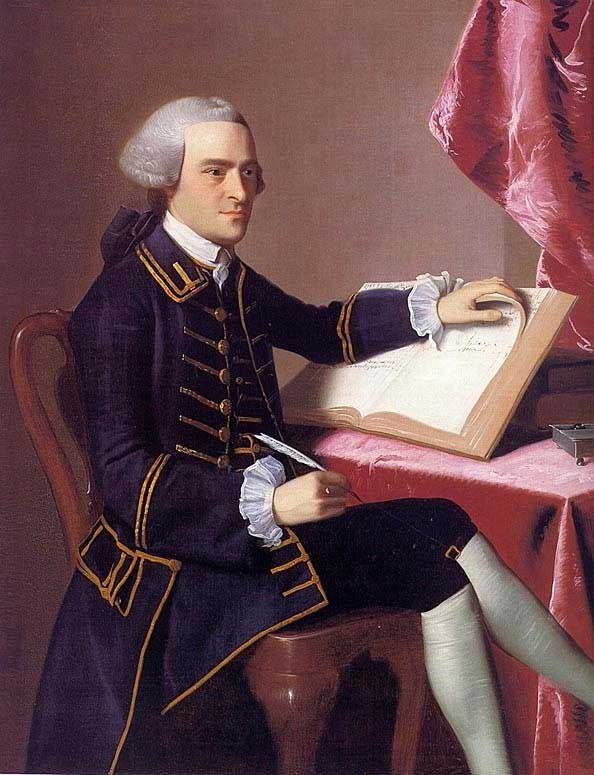
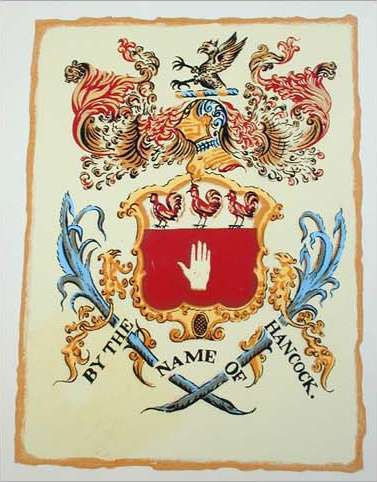
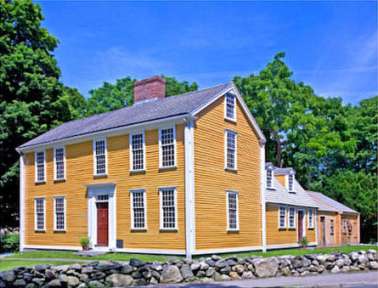
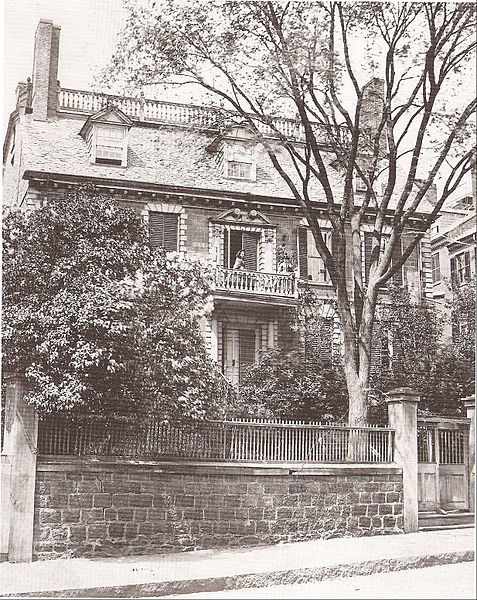
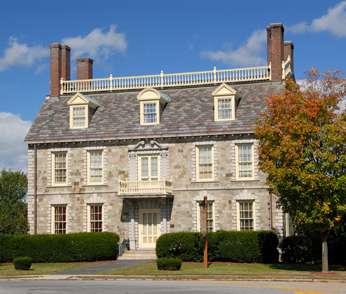
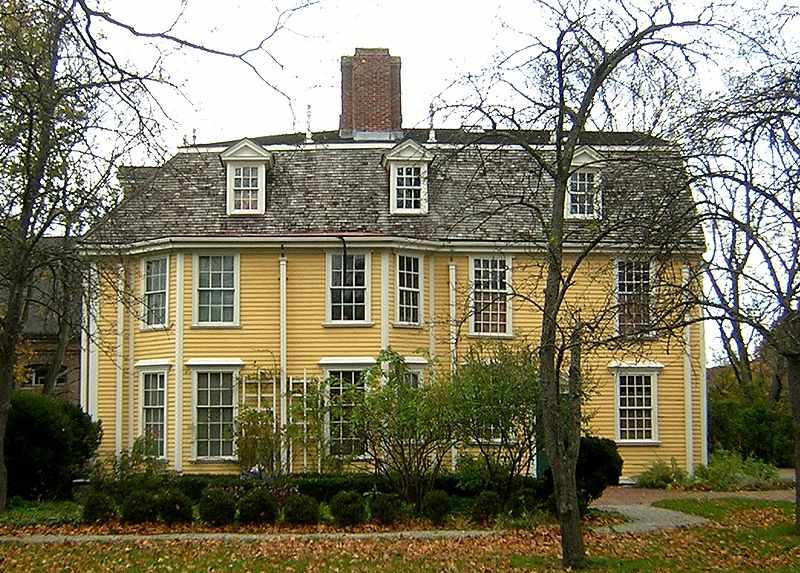
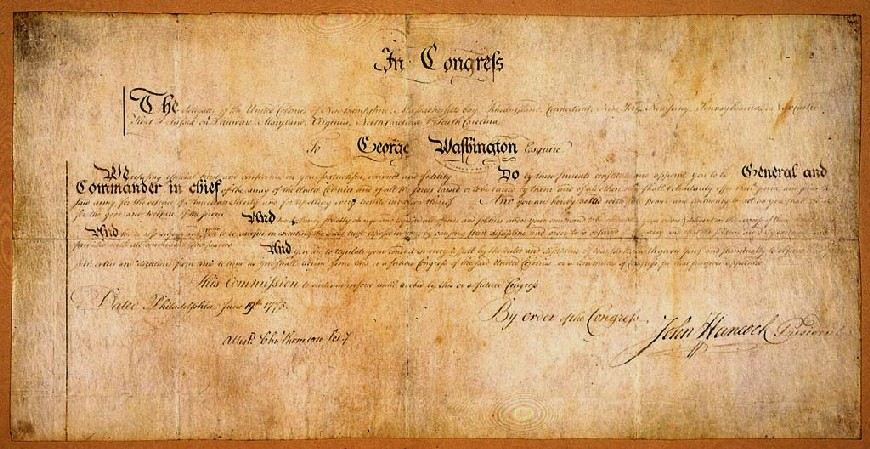
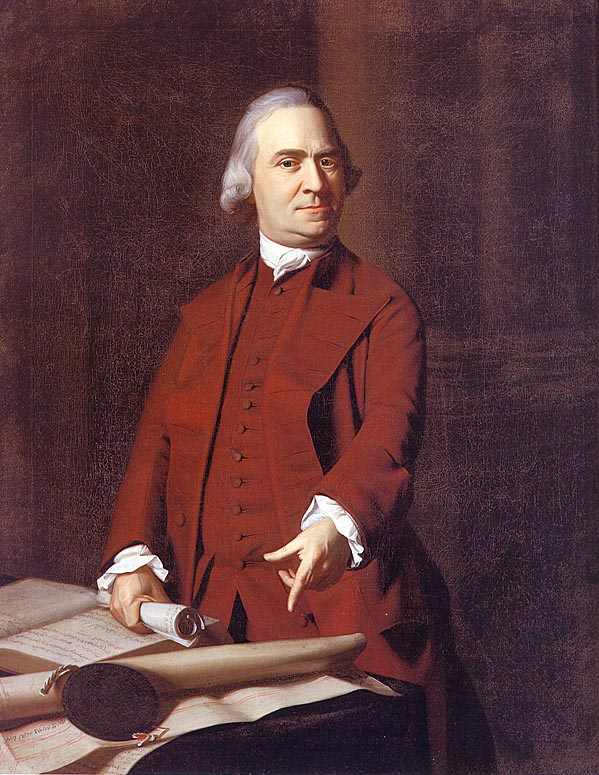
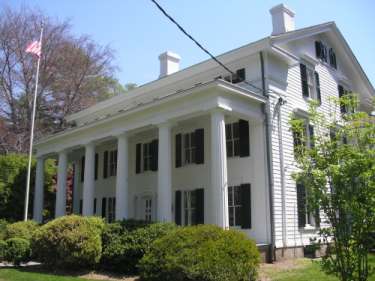
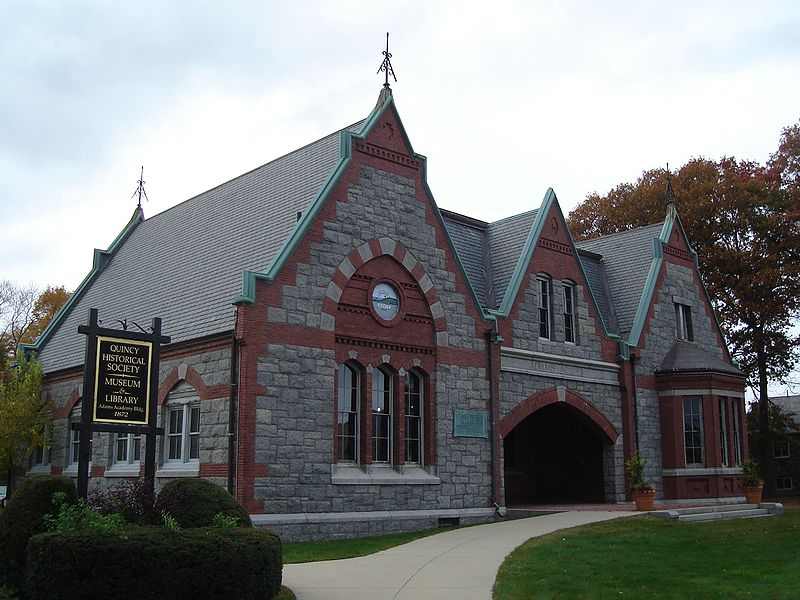
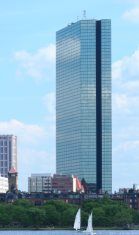
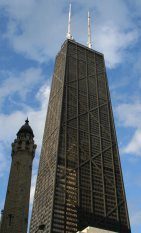

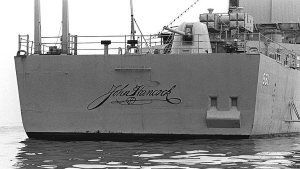










Facebook Comments